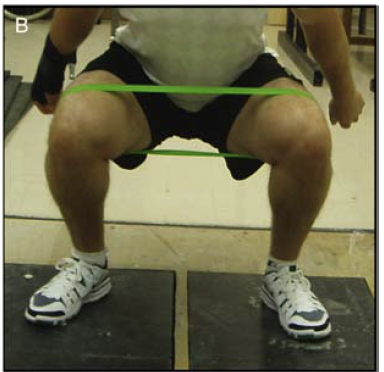Wearing bands around thighs to influence knee motion, whales, and creativity
📝 Weekly paper summary
The influence of resistance bands on frontal plane knee mechanics during body-weight squat and vertical jump movements (Gooyers et al., 2012)
Category
Repeated-measures design
Context
Practitioners commonly screen for uncontrolled frontal plane knee motion during exercise, given its link to injury risk. Some researchers have highlighted that excessive frontal plane knee motion may reflect inadequate control strategies for the hip musculature. Therefore, it's become common for coaches to use elastic bands as a tactile cue to "spread" the knees apart during lower extremity exercises:

However, until this study's publication, no research had assessed the efficacy of this intervention on reducing frontal plane knee motion or the knee abduction moments associated with loading passive structures of the knee. Therefore, this study's purpose was to assess the influence of using a resistance band on frontal plane knee kinematics and kinetics during a body-weight squat, a countermovement jump, and a squat jump.
Correctness
There's a critical delimitation to this study to highlight regarding the placement of the band. In this study, the researchers placed the band about 10cm proximal to the knee joint (shown above), but it's also common to put the bands below the knee joint:

While either band placement is particularly defensible, I think the response could be different with the different band placements. I've always found anecdotally it's a bit easier to "feel the band" with it placed slightly distal versus proximal to the knee joint. The main reason for this band placement in this study is that if the band is placed proximally (as shown above), the bands' tension would need to be measured and applied to the biomechanical model during the bottoms-up inverse dynamics calculations for computing knee net joint moments. However, measuring the band tension accurately in commercial gym equipment is not as accessible as it might sound. With the band above the knee joint, the net joint moments would already have this tension "built-in" to the calculations.
Another limitation (in hindsight) is that they normalized their knee abduction moments by the product of body mass and height. However, our lab's recent data regarding the statistical assumptions during data normalization (highlighted in the February 8th newsletter) suggest that this might have been inappropriate since it could skew their net joint moment data.
Contributions
- Placing resistance bands around the knees increased frontal plane knee motion and moments
- Using a stiffer band resulted in larger increases in frontal plane knee motion and moments relative to the lighter band
- Other forms of cueing/feedback are perhaps more effective for changing frontal plane knee motion and moments relative to using bands around the thighs
🧠 Fun fact of the week
We know blue whales are pretty big, but did you know their tongues are the same mass, if not larger, than some elephants? Even for a whale, their tongues are proportionally larger than humans' or dogs' tongues. What gives? Since they are filter feeders, they use their tongue to expel water through their teeth to feed on krill. To move that volume out of their mouths requires a pretty large muscle, hence their large tongues!
🎙 Podcast recommendation
🗣 Quote of the week
"I am enough of an artist to draw freely upon my imagination. Imagination is more important than knowledge. Knowledge is limited. Imagination encircles the world."
- Albert Einstein
